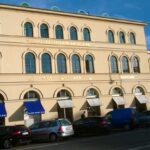Munich, Bavaria’s capital, is home to centuries-old buildings and numerous museums. The city is known for its annual Oktoberfest celebration and its beer halls, including the famed Hofbräuhaus, founded in 1589. In the Altstadt (Old Town), central Marienplatz square contains landmarks such as Neo-Gothic Neues Rathaus (town hall), with a popular glockenspiel show that chimes and reenacts stories from the 16th century.
The Bavarian capital of Munich held a special place in the Nazi regime. It was the “Hauptstadt der Bewegung” – the Capital of the Movement – the birthplace of the Nazi Party. Throughout the Third Reich period, Munich remained the spiritual capital of the Nazi movement, with headquarters buildings, museums to house the forms of artworks approved by Adolf Hitler, and shrines to the attempted Nazi putsch in November 1923. These sites were used as the scenes of lavish annual memorial ceremonies, and swearing-in ceremonies for new SS members. the city has a volatile past, especially during the years when Hitler and his Nazi Party began their first violent grabs for power. From the beer halls where he gathered his supporters.
Considering Hitler was notoriously a teetotaller, you might be surprised to learn that the Nazis actually got their start in some of Munich’s most famous beer halls. At least one of these historic institutions is still standing. The Hofbräuhaus was an early gathering place for Hitler and his supporters, where the alcohol only inflamed their misguided opinions. I along with my wife Guddi and son Dobin visited this beer hall, which has a friendly atmosphere you wouldn’t typically associate with a dictator. Some of the photographs published below will give the idea of these places during the Nazi Regime.
Another beer hall, the Bürgerbräukeller, was the site of “The Beer Hall Putsch,” an unsuccessful early attempt to seize power. After leaving the beer hall in a drunken state, a group of Hitler’s supporters attempted to storm the Bavarian Defence Ministry. Putsch attempt almost fell apart during the night. Hitler was arrested and tried for treason, and sentenced to five years in prison (he actually served only about nine months in Landsberg Prison). After his release he worked to rebuild the Nazi Party, leading to the Nazi takeover of power in Berlin in 1933.
Please click any picture to see enlarge view





























